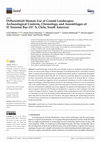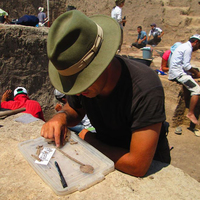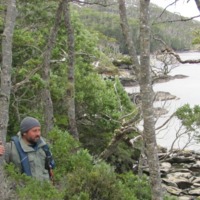Papers by Daniela Villalón
Chungará (Arica), 2016
Se presenta el análisis zooarqueológico de los restos de guanacos (Lama guanicoe) recuperados de ... more Se presenta el análisis zooarqueológico de los restos de guanacos (Lama guanicoe) recuperados de la ocupación Arcaica Tardía del sitio MAU085, emplazado en el valle de Mauro, Norte Semiárido chileno. Este análisis tuvo por objetivo entender la organización espacial del sitio, el cual corresponde a un campamento de cazadores-recolectores orientado al procesamiento de animales, entre otras actividades. El conjunto de análisis realizados apunta a una ocupación no estival y reiterada del sitio desde el 3.200 hasta los 2.500 años a.p., con una organización espacial relacionada a actividades de procesamiento, descarte y transporte principalmente de guanacos, junto a la confección y preparación de artefactos líticos de apropiación.

Land, 2021
Coastal landscapes of the Pacific coast of South America are regarded as bountiful biomes, as the... more Coastal landscapes of the Pacific coast of South America are regarded as bountiful biomes, as they are zones on the fringes of Eastern Boundary Upwelling Ecosystems. Cumulative research shows an almost uninterrupted presence of mobile hunter-fisher-gatherer communities throughout the Holocene in North-Central Chile (29°–32° S). However, local-scale differences reveal the variability that is concealed by this broad characterization. Recent research in El Teniente Bay (31° S) shows few sites and occupations suggestive of low occupational redundancy as well as reduced archaeological assemblages, indicating limited activities in this landscape. However, several occupations date to the middle Holocene, a period when discontinuities in human occupations in response to adverse environmental conditions have been suggested on regional and supraregional scales. The main occupations detected at El Teniente are interpreted as a response to such conditions and in the context of changes in land u...

Land, 2021
Coastal landscapes of the Pacific coast of South America are regarded as bountiful biomes, as the... more Coastal landscapes of the Pacific coast of South America are regarded as bountiful biomes, as they are zones on the fringes of Eastern Boundary Upwelling Ecosystems. Cumulative research shows an almost uninterrupted presence of mobile hunter-fisher-gatherer communities throughout the Holocene in North-Central Chile (29�–32� S). However, local-scale differences reveal the variability that is concealed by this broad characterization. Recent research in El Teniente Bay (31� S) shows
few sites and occupations suggestive of low occupational redundancy as well as reduced archaeological assemblages, indicating limited activities in this landscape. However, several occupations date to the middle Holocene, a period when discontinuities in human occupations in response to adverse environmental conditions have been suggested on regional and supraregional scales. The main occupations detected at El Teniente are interpreted as a response to such conditions and in the context of changes in land use. Despite the spottiness of the archaeological record of El Teniente Bay, it is important in terms of its chronology and the differing trends in the use of space in comparison to other areas that have been the focuses of research. This paper addresses the archaeological record of El Teniente Bay and discusses its implications for human land use in the wider area of the coast of North-Central Chile.

Se presenta el análisis zooarqueológico de los restos de guanacos (Lama guanicoe) recuperados de ... more Se presenta el análisis zooarqueológico de los restos de guanacos (Lama guanicoe) recuperados de la ocupación Arcaica Tardía del sitio MAU085, emplazado en el valle de Mauro, Norte Semiárido chileno. Este análisis tuvo por objetivo entender la organización espacial del sitio, el cual corresponde a un campamento de cazadores-recolectores orientado al procesamiento de animales, entre otras actividades. El conjunto de análisis realizados apunta a una ocupación no estival y reiterada del sitio desde el 3.200 hasta los 2.500 años a.p., con una organización espacial relacionada a actividades de procesamiento, descarte y transporte principalmente de guanacos, junto a la confección y preparación de artefactos líticos de apropiación. Here we present the zooarchaeological analysis of guanaco (Lama guanicoe) remains recovered from the Late Archaic occupation in the MAU085 site, located in the Mauro Valley, in the semi-arid north of Chile. The aim of this study is to understand the spatial organization of this hunter-gatherer site mainly focused on animal processing activities. The results suggest a redundant seasonal (non estival) occupation of the site between 3,200 to 2,500 yr BP, showing a marked spatial organization related principally to guanaco processing, transport and disposal activities together with the elaboration and preparation of lithic appropriation artifacts.
Thesis Chapters by Daniela Villalón
30 de marzo 2016i AGRADECIMIENTOS En primer lugar Andrés Troncoso, muchas gracias por emprender d... more 30 de marzo 2016i AGRADECIMIENTOS En primer lugar Andrés Troncoso, muchas gracias por emprender desde el primer momento este trabajo conmigo y al final aceptar guiar esta Memoria. Tus consejos, todas las revisiones y comentarios fueron clave para lograr llegar al final del camino y sacar esto adelante. Infinito agradecimiento por tu paciencia a lo largo de los casi tres años que hemos trabajado este proyecto. Daniel Pavlovic por brindarme valiosa información, por todo el material del Proyecto











Uploads
Papers by Daniela Villalón
few sites and occupations suggestive of low occupational redundancy as well as reduced archaeological assemblages, indicating limited activities in this landscape. However, several occupations date to the middle Holocene, a period when discontinuities in human occupations in response to adverse environmental conditions have been suggested on regional and supraregional scales. The main occupations detected at El Teniente are interpreted as a response to such conditions and in the context of changes in land use. Despite the spottiness of the archaeological record of El Teniente Bay, it is important in terms of its chronology and the differing trends in the use of space in comparison to other areas that have been the focuses of research. This paper addresses the archaeological record of El Teniente Bay and discusses its implications for human land use in the wider area of the coast of North-Central Chile.
Thesis Chapters by Daniela Villalón
few sites and occupations suggestive of low occupational redundancy as well as reduced archaeological assemblages, indicating limited activities in this landscape. However, several occupations date to the middle Holocene, a period when discontinuities in human occupations in response to adverse environmental conditions have been suggested on regional and supraregional scales. The main occupations detected at El Teniente are interpreted as a response to such conditions and in the context of changes in land use. Despite the spottiness of the archaeological record of El Teniente Bay, it is important in terms of its chronology and the differing trends in the use of space in comparison to other areas that have been the focuses of research. This paper addresses the archaeological record of El Teniente Bay and discusses its implications for human land use in the wider area of the coast of North-Central Chile.